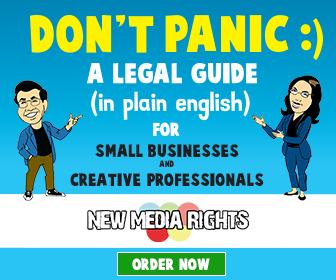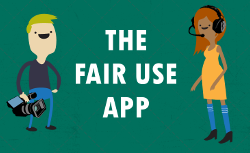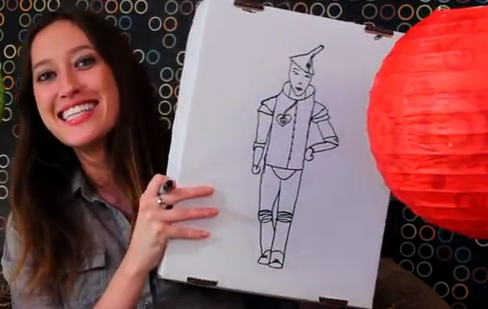Submitted by New Media Rights last modified Thu, 09/11/2014 - 2:25pm
Copyright 101
What is copyright?
Copyright is a form of intellectual property that gives the creator of a variety of creative works like paintings, novels, music, and sculptures the right to keep others from copying their work. It also covers digital works like videos, CAD files, and images on websites. Typically, the creator of the work is the owner of the copyright, but that is not always the case. The creator can transfer all or some copyrights to another person. This guide refers to the copyright holder as the “creator.” For more information, check out, “What is copyright law, who created it, and why do people think we need it?”
What does copyright law protect?
Copyright law protects the creator’s right to copy, distribute, publicly display, publicly perform, and create derivatives of the original work. It protects the creative expression in that work, but not the basic facts or general ideas contained in the work. For more information, check out, “Now That I Have A Copyright To Something, What Does This Allow Me to Do?”
How do you get copyright protection?
As soon as an original work is “fixed in a tangible medium,” it qualifies for copyright protection. Basically, copyright protects your work as soon as your creative idea is expressed in the physical world. For example, when an author begins writing, everything that was committed to paper (or an electronic file), is protected. “Original” is a very low bar, so as long as there is some minimal level of creativity a work is likely to meet this requirement. See “What Can Be Copyrighted” and “What Can’t Be Copyrighted”.
To further protect a work, the creator can register the work with the US Copyright Office. For more information on registration, see http://www.copyright.gov.
How long does copyright protection last for?
As a society, we want ideas to be free flowing. However, creators should be rewarded for their labor, and allowed the chance to profit from their work. As of 1978, the duration of a copyright is the creator’s life plus 70 years. Prior to 1978, the duration differs upon creation date. For a useful chart on copyright duration, see http://copyright.cornell.edu/resources/publicdomain.cfm.
What if a work is both creative and useful?
If a work has both creative and useful elements, then copyright will protect the creative elements of the work, but not the useful elements. This concept is called “severability.” Let’s say you have a bed with an artistic headboard. The rest of the frame is standard and useful. Copyright law would protect the artistic elements of the headboard, but not the rest of the bed frame. One could copy the bed frame, less the headboard, without violating copyright law. In instances where it is hard to separate the creative elements from the useful elements, a court tends to make the work available to the public instead of granting copyright protection to any part of the work.
If you have any other questions regarding 3D printing and the law please don’t hesitate to contact New Media Rights via our contact form.
Ways to use legally use another’s copyrighted work.
Copyright does not provide an infinite and impenetrable barrier of rights. There are three ways to use another’s work without violating the copyright owner’s copyright: get permission through a license, use something from the public domain, or relying on fair use.
Licensing a copyrighted work directly
One way to use another’s work without violating the copyright owner’s copyright is to obtain permission directly from the creator to do so. Permission from the creator is ‘license’ to use his or her work, and usually comes in the form of a written contract you both sign and agree to. However, keep in mind that a license can be limited. The creators of a TV show might give a fan permission to publish written fan fiction, but not to upload the whole TV show to YouTube.If there is an object or file you would like to scan or use, you could contact the object or file creator and ask them for permission to use their work. The trick here is to ask permission from the right person(s). For example, the creator of a 3D-printable file of a sculpture might not be the actual creator of the sculpture. If the only thing in the file is the sculpture, you should ask permission from the sculptor, not the file creator.
Using open licensed works under Creative Commons and other licensesAnother form of getting permission is relying on an open license. Here you are again relying on permission from the copyright owner, but the good news is that there’s no need to negotiate. If a work is openly licensed, it should be clearly labeled that way. When a copyright owner shares their work with the public via Creative Commons license (the most common open content license), they allow anyone to use that work so long as they follow the requirements of that specific license. For example, the creator of a 3D image might be happy to offer the image for free and to have others modify the file, so long as they are attributed for creating the 3D image. The original creator might make the image available via a Creative Commons Attribution license. This requires that anyone who uses or modifies that image must provide attribution to the original creator (i.e. letting people know that they used your work). There are several other conditions you could place on your Creative Commons work such as non-commercial or no derivatives. You can read more about properly using Creative Commons licenses in our guide here.
Public Domain Works
Once the copyright protection on a work expires, the work enters the public domain. When a work is in the public domain, it is free for all to use as they see fit. For example, Michelangelo’s David is in the public domain because any copyright protection it had, if any, has expired by now. Alternatively, a creator can actively put the work in the public domain. A word of caution: Don’t believe everything you read online. Just because someone uploads a 3D file of Simba from The Lion King and says it is in the public domain, it doesn’t mean it is. Disney certainly wouldn’t agree. Only the owner of the copyright can release it into the public domain. Figuring out if something is in the public domain can be tricky.
It might be helpful to check out this chart to determine whether a copyright term has expired and entered into the public domain.Fair Use Of A Copyrighted Work
Fair use is a specific way to use a work that does not violate the creator’s copyright. Determining whether a use qualifies as ‘fair use’ is not clean-cut. Generally, a court will look at the 1) purpose and character of the use, 2) nature of the copyrighted work, 3) amount and substantiality of the portion used, and 4) the economic effect the use will have on the original.
“Purpose and character of the use” relates to how you plan to use the specific copyrighted material and your project as a whole. The more transformative your use is, the more likely it qualifies as fair use. The more commercial it is, the less likely it counts are fair use. However, a work can still be fair use even if it is used commercially; it’s simply one thing that counts against fair use. For example, let’s say a person took a CAD file of a macho male video game character and modified it so it was wearing stereotypically female in game body armor. This use would be transformative since they are using the male video game character to comment on gender in video games. This transformation tends towards fair use. However if they were to start selling the file their fair use argument might be weakened.
“Nature of the copyrighted work” looks at the original work. Is the original a highly creative fictional work, or is it based heavily on fact and reality? The more creative the original is, the more protection it will get. The more fact-based it is, the thinner the protection will be. For example, if someone made a scaled-down version of the pyramids with miniature tourists taking photos, the creator would have very little copyright protection because they are depicting something in the public domain that actually exists. Only if someone made an exact duplicate of the work with tourists in the exact same position and with the exact same appearance, would there be copyright infringement. Compare that to a sculpture of a whale with barnacles in the shape of a city skyline sculpture. This sculpture will be afforded stronger copyright protection because it is a highly creative work.
This factor also looks at whether a work is published or unpublished. Unpublished works receive more protection under copyright than published works. Let’s say Marvin created a CAD file but had only shown it to Jane. Jane though his CAD file design was absurd and wanted to write about it on her blog and include a copy of the entire CAD file. Because the CAD file is unpublished, sharing it especially in whole is much less likely to be fair use.
“Amount and substantiality of portion used” looks at how much of the original was used. The more one takes from the original, the less likely one’s work qualifies for fair use. Going back to the whale example above. Copying one barnacle from the whale sculpture is more likely fair use than copying the whole whale. That said context is also important. If copying one barnacle and transform it as part of an original work of art is more likely to be fair use than just making a verbatim copy of one barnacle.
“Effect on market value” considers how much the copy is a substitute for the original, thus depriving the original creator from revenue. For example, selling a 3D file for an existing Simpsons Lego Minifigure would be less likely to be fair use. After all no one needs to go out and buy that Simpsons Lego Minifigure, because they can just print a copy at home. However, if you made a 3D file for toy people who look just like your specific family members, but have Lego-compatible feet, your fair use defense is stronger. Your toy family is not a substitute for anything the LEGO Group currently makes or from which it would profit.
If you have any other questions regarding 3D printing and the law please don’t hesitate to contact New Media Rights via our contact form.




